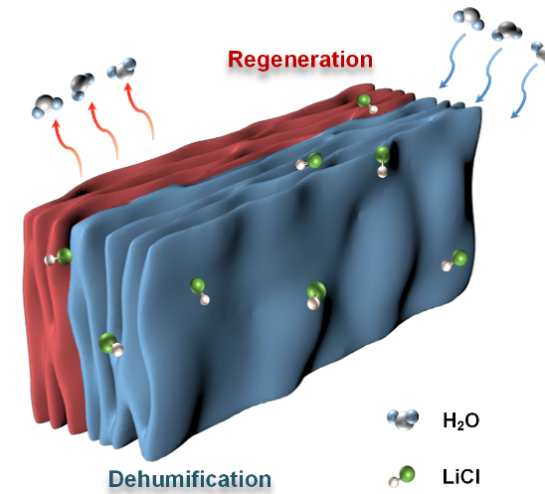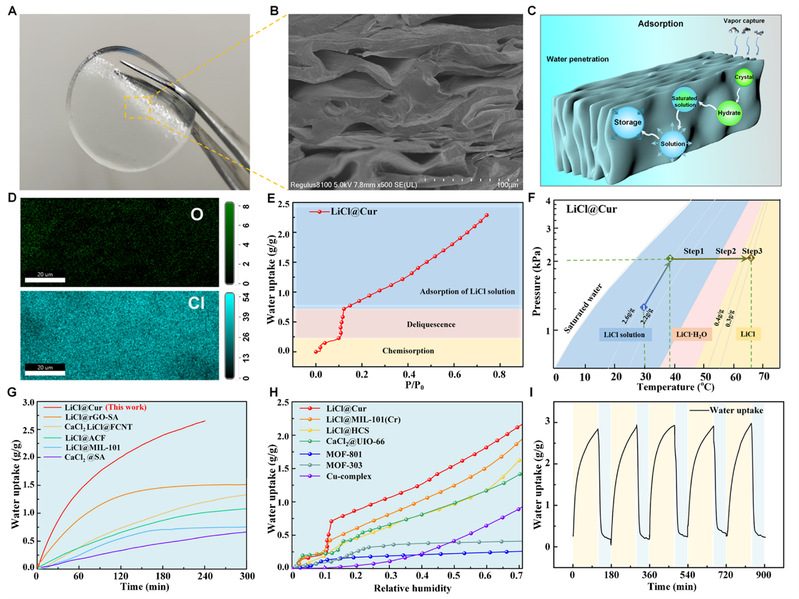Recently, Professor Zhang Hua's team of our hospital and Professor Wang Ruzhu's team of Shanghai Jiaotong University published a research paper on Cell Reports Physical Science entitled “An ultra hygroscopic polymer for high efficiency desorption, and reported a new gel based adsorbent LiCl@Cur Efficient dehumidification technology”. This paper is a joint research achievement between our school and Shanghai Jiao Tong University. Our school is the first unit, with graduate student Pan Yu as the first author, Associate Professor Wang Jiayun of the School of Activism as the corresponding author, and graduate students Zhong Guodong, Associate Professors Gao Peng, Professor Zhang Hua, and Professor Wang Ruzhu as co authors.
【Research Background】
Dehumidification technology is an effective way to regulate the humidity of production and living environments. The dehumidification heat exchanger coupled with solid desiccants has the advantages of efficient dehumidification and low grade heat source drive, with significant energy efficiency improvement. The adsorption heat and desorption heat generated by the desiccant attached to the fins can be promptly taken away and provided by the medium inside the heat exchanger, achieving efficient adsorption and regeneration, thereby improving the overall dehumidification efficiency of the system. In recent years, domestic and foreign scholars have conducted research on the material properties, bonding methods, and heat and mass transfer characteristics of desiccants for dehumidification heat exchangers. Among them, the material properties of desiccants for dehumidification heat exchangers are crucial. However, the low adsorption capacity, slow kinetic speed, and high energy consumption of existing desiccants limit the dehumidification efficiency of dehumidification heat exchangers. In response to this dilemma, the refrigeration low-temperature innovation team of the School of Energy and Power of our school has developed a hydrogel based composite adsorbent with high efficiency and low cost, as well as a dehumidification heat exchanger using this adsorbent. Through performance testing of new materials, simulation optimization and experimental testing of new dehumidification heat exchanger, systematic research from material optimization application has been completed.
【Main content】
This paper presents the preparation of a novel and efficient composite material using a composite of a natural rubber matrix and a hygroscopic salt LiCl LiCl@Cur Isothermal adsorption, dynamic adsorption, and cyclic testing were conducted on it. Under low humidity conditions of 30% RH&30 ° C, LiCl@Cur The adsorption capacity is as high as 2.65 g/g, and the adsorption rate coefficient k reaches 1.84 × 10-4 s-1 and exhibits good cyclic stability.
In order to study the dehumidification performance of a new type of dehumidification heat exchanger, the paper first used COMSOL software to simulate and optimize the structure of the dehumidification heat exchanger. The optimal dehumidification efficiency was achieved in a structure with a fin spacing of 2.2 mm and an adsorption layer thickness of 0.2 mm. Based on the optimized materials, the preparation cost is low, the simple gel based dehumidification heat exchanger CLCHE is manufactured, and the dehumidification performance test bench for CLCHE is built and tested. CLCHE has good stability during the adsorption desorption cycle. Through a CLCHE channel of only 15 mm, the dew point temperature difference between the inlet and outlet air can reach 30 ° C, indicating strong deep dehumidification potential.
【Summary and Outlook】
For the first time, the college's refrigeration low-temperature innovation team has used the Kedaran based composite desiccant for dehumidification. Its super hygroscopic performance can achieve efficient and deep dehumidification, and has broad application prospects in fields such as electrode production, low-temperature drying, and green buildings. This research work has been supported by the Youth Program of the National Natural Science Foundation of China (52006145), the Shanghai Morning Light Program (19CG54), the Shanghai Youth Talent Program Sailing Project (20YF1431500), and the Shanghai Central Guiding Local Science and Technology Development Fund (No. YDZX20213100003002).
Cell Reports Physical Science is a highly influential comprehensive journal launched by Cell Press Publishing Group, aiming to publish significant research progress in physics, chemistry, energy science, materials science, and interdisciplinary fields.
Paper link: https://doi.org/10.1016/j.xcrp.2023.101554



